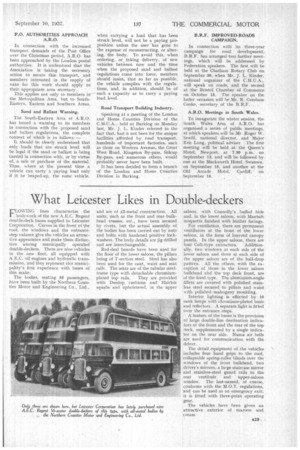What Leicester Likes in Double-deckers F LOWING lines characterize the bodywork
Page 53

If you've noticed an error in this article please click here to report it so we can fix it.
of the new A.E.C. Regent double-deck buses supplied to Leicester Corporation. Curves in the front of the roof, the windows and the entrancestep valance give the vehicles an attractive appearance and make them distinctive among municipally operated double-deckers. There are nine vehicles in the new fleet, all equipped with A.E.C. oil engines and hydraulic transmission, and they represent this munici-. pality's first experience with buses of this make.
The bodies, seating 56 passengers, have been built by the Northern Counties Motor and Engineering Co., Ltd., and are of all-metal construction. All units, such as the front and rear bulkhead trusses, etc., have been secured by rivets, but the actual assembly of the bodies has been carried out by nuts and bolts with hardened positive lockwashers. The body details are jig drilled and are interchangeable.
Red-deal boards have been used for the floor of the lower saloon, the pillars being of T-section steel. Steel has also been used for the cant, waist and seat rails, The seats are of the tubular steelframe type with detachable chromium plated top rails. They are provided with Dunlop cushions and Hairlok squabs and upholstered, in the upper saloon, with Connolly's buffed hide and, in the lower saloon, with Maxtuft moquette finished with leather facings.
For ventilation, there are permanent ventilators at the front of the lower saloon, in the form of louvred canopy panels. In the upper saloon, there are
four Colt-type extractors. Additionally, two windows at each side of the lower saloon and three at each side of the upper saloon are of the half-drop pattern. All the others, with the exception of those in the lower saloon bulkhead and the top deck front, are of the fixed type. The aluminium-angle fillets are covered with polished stainless steel secured to pillars and waist with polished mahogany moulding.
Interior lighting is effected by 10 sunk lamps with chromium-plated basis and reflectors. A separate light is fitted over the entrance steps.
A feature of the buses is the provision of large double-line destination indicators at the front and the rear of the top deck, supplemented by a single indicator on the near side. Numa air bells are used for communication with the driver.
The detail equipment of the vehicles includes four hand grips to the roof, collapsable spring-roller blinds over the windows of the front bulkhead, two driver's mirrors; a large staircase mirror and stainless-steel guard rails to the rear vestibule and upper-saloon window. The last-named, of course, conforms with the M.O.T. regulations, and can be used as an emergency exit; it is fitted with three-point operating gear.
The vehicles have been given an attractive exterior of maroon and cream.




























































































